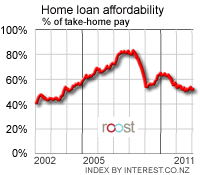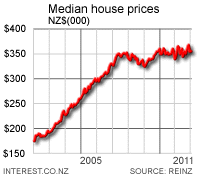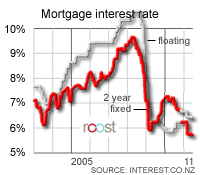 The New Zealand Housing Affordability measure from interest.co.nz was largely unchanged in February as a small rise in the median house price offset the benefits of another fall in mortgage rates. (Update to include interactive chart.) The pause in the improving trend for housing affordability is not expected to last for long given predictions that house prices and interest rates will fall further later this year. Fresh tax cuts later in 2009 will also increase take-home pay and improve affordability. Affordability recovered dramatically through 2008 as both the slumping housing market and an unprecedented fall in fixed mortgage rates made it easier for both first home buyers and established households to buy houses. A reduction in tax rates and income thresholds also helped lift disposable incomes. Interest.co.nz is predicting that housing is likely to be largely affordable for most first home buyers by the end of 2009 if house prices keep falling, interest rates fall further and tax cuts are implemented.
The New Zealand Housing Affordability measure from interest.co.nz was largely unchanged in February as a small rise in the median house price offset the benefits of another fall in mortgage rates. (Update to include interactive chart.) The pause in the improving trend for housing affordability is not expected to last for long given predictions that house prices and interest rates will fall further later this year. Fresh tax cuts later in 2009 will also increase take-home pay and improve affordability. Affordability recovered dramatically through 2008 as both the slumping housing market and an unprecedented fall in fixed mortgage rates made it easier for both first home buyers and established households to buy houses. A reduction in tax rates and income thresholds also helped lift disposable incomes. Interest.co.nz is predicting that housing is likely to be largely affordable for most first home buyers by the end of 2009 if house prices keep falling, interest rates fall further and tax cuts are implemented.
 "Affordability for most home buyers has improved dramatically and will continue to get better through the rest of 2009 as house prices ease and take-home pay improves, thanks to expected tax cuts," said Interest.co.nz Editor Bernard Hickey. "The only complication for first home buyers is the increasing requirement by banks for a deposit of 20% or more, which is making housing effectively less affordable," Hickey said. The REINZ median house price rose to NZ$330,000 from NZ$325,000 in January, eating up the benefits from a drop in the average 2 year mortgage rate for new borrowers to 5.92% from 6.10% the previous month. The proportion of an after-tax median income needed to service the mortgage for the median house fell to 54.0% in February from 54.1% in January. This is down from a peak of 82.9% in November 2007 when the median house price was NZ$352,000 and the 2 year fixed mortgage rate was at 8.75%. However, affordability remains slightly out of reach for most individual home buyers. The threshold proportion of after tax income considered prudent to sustainably own a house is around 40%. Anything above that is starting to become unaffordable. The Housing Affordability report's measure of affordability for a typical first home buyer shows the mortgage servicing proportion at 47.1% in February, up slightly from 46.8% in January and down from 70.1% a year earlier. This measure is for a median income earner aged 25-29 buying a first quartile home. Interest.co.nz thinks the "˜affordable' threshold is 40% for such a home buyer.
"Affordability for most home buyers has improved dramatically and will continue to get better through the rest of 2009 as house prices ease and take-home pay improves, thanks to expected tax cuts," said Interest.co.nz Editor Bernard Hickey. "The only complication for first home buyers is the increasing requirement by banks for a deposit of 20% or more, which is making housing effectively less affordable," Hickey said. The REINZ median house price rose to NZ$330,000 from NZ$325,000 in January, eating up the benefits from a drop in the average 2 year mortgage rate for new borrowers to 5.92% from 6.10% the previous month. The proportion of an after-tax median income needed to service the mortgage for the median house fell to 54.0% in February from 54.1% in January. This is down from a peak of 82.9% in November 2007 when the median house price was NZ$352,000 and the 2 year fixed mortgage rate was at 8.75%. However, affordability remains slightly out of reach for most individual home buyers. The threshold proportion of after tax income considered prudent to sustainably own a house is around 40%. Anything above that is starting to become unaffordable. The Housing Affordability report's measure of affordability for a typical first home buyer shows the mortgage servicing proportion at 47.1% in February, up slightly from 46.8% in January and down from 70.1% a year earlier. This measure is for a median income earner aged 25-29 buying a first quartile home. Interest.co.nz thinks the "˜affordable' threshold is 40% for such a home buyer.  The report's measure of affordability for a "˜typical' household shows that proportion dropped to 35.3% in February from 35.4% in January. This is down from 52.3% a year ago and a peak of 54.1% in March 2008. This "˜typical' household includes one 30-34 year old male earning a median income, one 30-34 year old female earning 50% of a medium income and one child over five. Interest.co.nz thinks the "˜affordable' threshold is 30% for such a household. The report's measure of a "˜typical' first home buying household shows the proportion required to buy the first quartile home increased slightly to 22.3% in February from 22.1% in January. It has, however, improved from 33.1% a year ago and 34.9% at its peak in November 2007. This measure is for one full time male aged 25-29 and one full time female aged 25-29 with no kids. Interest.co.nz considers the affordability threshold for this group as 30%, although that doesn't leave room for children. Four of the 12 regions surveyed in the Home Loan Affordability report showed improvements in affordability, including Auckland, Taranaki, Canterbury and Central Otago Lakes. This was largely because house prices fell in these areas. Eight the regions showed deteriorations, including Northland, Waikato/Bay of Plenty, Hawkes Bay/Gisborne, Manawatu/Wanganui, Wellington, Nelson/Marlborough, Otago and Southland. House prices rose in these areas. Southland continued to be the cheapest region in the nation with the typical home buyer having to pay 32% of take-home pay to afford the mortgage on a median house. The most expensive region was Central Otago Lakes region on 74.9%.
The report's measure of affordability for a "˜typical' household shows that proportion dropped to 35.3% in February from 35.4% in January. This is down from 52.3% a year ago and a peak of 54.1% in March 2008. This "˜typical' household includes one 30-34 year old male earning a median income, one 30-34 year old female earning 50% of a medium income and one child over five. Interest.co.nz thinks the "˜affordable' threshold is 30% for such a household. The report's measure of a "˜typical' first home buying household shows the proportion required to buy the first quartile home increased slightly to 22.3% in February from 22.1% in January. It has, however, improved from 33.1% a year ago and 34.9% at its peak in November 2007. This measure is for one full time male aged 25-29 and one full time female aged 25-29 with no kids. Interest.co.nz considers the affordability threshold for this group as 30%, although that doesn't leave room for children. Four of the 12 regions surveyed in the Home Loan Affordability report showed improvements in affordability, including Auckland, Taranaki, Canterbury and Central Otago Lakes. This was largely because house prices fell in these areas. Eight the regions showed deteriorations, including Northland, Waikato/Bay of Plenty, Hawkes Bay/Gisborne, Manawatu/Wanganui, Wellington, Nelson/Marlborough, Otago and Southland. House prices rose in these areas. Southland continued to be the cheapest region in the nation with the typical home buyer having to pay 32% of take-home pay to afford the mortgage on a median house. The most expensive region was Central Otago Lakes region on 74.9%.

We welcome your comments below. If you are not already registered, please register to comment.
Remember we welcome robust, respectful and insightful debate. We don't welcome abusive or defamatory comments and will de-register those repeatedly making such comments. Our current comment policy is here.